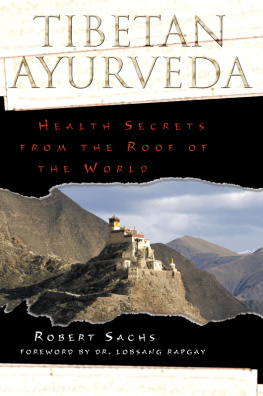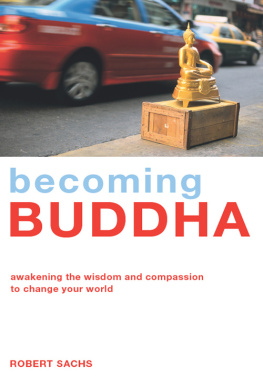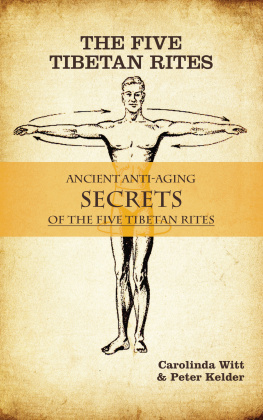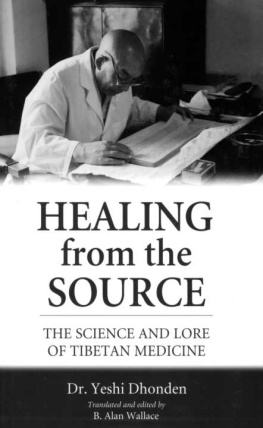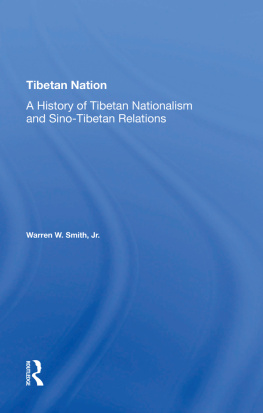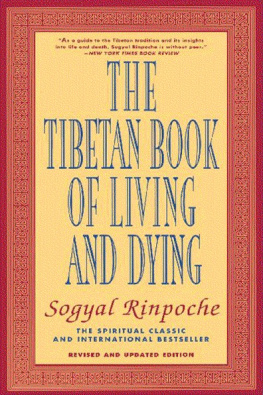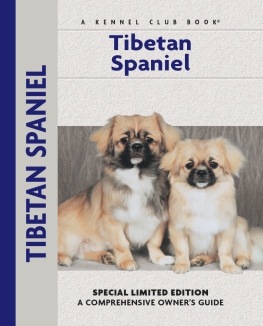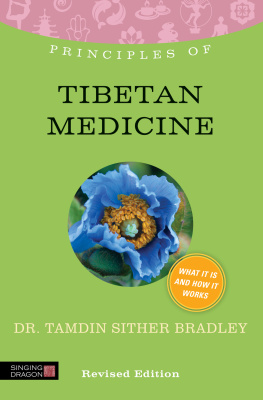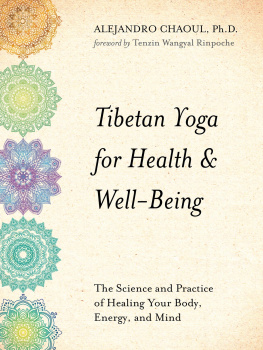TIBETAN
AYURVEDA
Health Secrets
from the Roof of
the World
ROBERT SACHS
Drawings by Dorje Gyaltsen
Foreword by Dr. Lobsang Rapgay

Healing Arts Press
Rochester, Vermont
T his book is dedicated to my father, Sherman David Sachs, a veterinarian, who gave me many valuable lessons onpreventative health-care. Thanks, Dad. With much love and appreciation...
ACKNOWLEDGMENTS
T here are many volumes written by authors in both Eastern and the Western traditions that I am indebted to for their diligent work. I have divided the Bibliography so as to credit them in accordance with their specialty.
There are also many teachers I have encountered from various traditions over the years to whom I am indebted. First and foremost are my closest spiritual teachers, the Venerable Khenpo Karthar, Rinpoche, and Chime Rinpoche, who over the years have continued to give me meditation instruction and guidance. Included with Khenpo Rinpoche and Chime Rinpoche is the Venerable Chogyam Trungpa, Rinpoche, whose Shambhala Training has had a profound impact on my meditation practice and the mindfulness in which I engage in all activities of my life. Also, to my dear friend and an excellent lama, Ole Nydahl, who has been able to transform Tibetan Buddhism to fit contemporary Western minds. To these four I am grateful. They provide the source material for much of the spiritual dialogue throughout this book and the overview of meditation practice and its relevance to daily life.
I want to thank my close friend and teacher Rex Lassalle for being an example to me in how to integrate preventive health-care practices into daily life. His training programs in martial arts exercise and shiatsu prepared me for my training with the late Tibetan tai chi master Liu Siong, whom I also wish to thank. Rex was my benefactor for this training. He also brought me to study macrobiotics with Michio Kushi, whom I consider the buddha of food. It is my macrobiotic training with Michio that has made it possible for me to comprehend and modernize the teachings on nutrition in Tibetan medicine. I also want to thank Michio for introducing me to the teachings on Nine-Star Ki astrology, a system found within Japanese, Chinese, and Tibetan astrology under different names. Material on Nine-Star Ki, called in Tibetan the system of mewas, is discussed in the chapter Meditation and Spiritual Practice and the final chapter, Time and Place, on how and when to integrate these practices into daily life. I thank Rex, again, for coaxing me to go deeper into the study of Nine-Star Ki.
From 1981 through 1986,1 had the great privilege of working with Dr. Walt Stoll of what was then the Holistic Medical Center in Lexington, Kentucky. A master allopathic physician with a profound respect for natural and holistic therapies, Walt was able to show me how to integrate divergent health practices and philosophies. Stoll is a pioneer and a good friend. I thank him for his example, the patronage that made it possible for me to train in the Medicine Buddha teachings and practice, and his relentless pursuit to find better methods to benefit his patients even when that means breaking ranks with the convention of the day.
I want to thank the various teachers of Tibetan medicine whom I have encountered: Dr. Yeshe Donden, Venerable Trogawa Rinpoche, osteopath Tom Dummer, and especially Dr. Lobsang Rapgay. It has been under the direct tutelage of Dr. Rapgay that I have not only studied materials from the Gyud-Zhi but have come into contact with other works of Tibetan teachers and their students and have been able to integrate other health-related knowledge from years with Khenpo Karthar, Rinpoche, and other masters and to reformulate years of alternative health-care training to fit within the framework of Tibetan medicine. Thus I pay a special tribute to Dr. Rapgay. He is a brilliant teacher and a good friend. Also, many thanks and namastes to Ayurvedic physicians Vasant Lad, Pakanj Naram, and especially Sunil Joshi. Dr. Joshi has been responsible for deepening my knowledge of the detoxification and rejuvenation practices of Ayurveda common both to Indian and Tibetan Ayurveda and continues to inspire me with his dedication to his clients.
My lifetime companion, Melanie, also deserves a special credit. A pioneer and original thinker, Melanie has often been the captain who has steered our course. Her interest in Ayurveda brought us to a place where we have learned more about the practical side of Tibetan medicine. Her theoretical knowledge is extensive, and her work in the area of beauty and rejuvenation brings Ayurveda to a new level in Western consciousness. In this volume, she has acted as consultant and support. I thank her for her support as a professional and as a wife. I openly proclaim my love and admiration for her as a partner whose hand I am proud to hold on the path of life.
I would also like to thank Thomas Bonner for photography that is the basis for many of the drawings in the book, Pat Hanaway for going through the entire text and offering suggestions for making fundamental concepts in Tibetan medicine clearer to the reader, and my editors, Sara Held and Ann Mason, who have been instrumental in steering this project to completion. Thanks also to Harmon Hough ton and Marcia Keegan.
Finally, since I am not a physician, the material I have presented in this book, while it represents years of training, is in no way comparable to the work of someone who has completed the ten to twenty years of study required to become a Tibetan doctor. This book is for preventive health-care purposes only. Although such practices can go a long way toward alleviating the pain and suffering we experience, they are not intended to replace diagnosis and treatment under the care of a competent physician or health-care practitioner of whatever tradition. At the same time, I encourage readers to discuss these practices with their health-care providers when appropriate so that a more extensive, more beneficial knowledge of health care and treatment can emerge for the benefit of all.
FOREWORD
K nowledge of the healing science of Tibet is slowly coming to the West as more and more publications in English are being made available to the non-Tibetan reader. Bob Sachss work Health for Life is a major departure from these publications because it not only emphasizes the practical side of Tibetan medicine but also integrates aspects of other related sciences of Tibet, such as Yantra Yoga, meditation, and spiritual practice, in a way that presents a true picture of the holistic nature of Tibetan medicine.
Tibetan medicine was probably the first integrated system of ancient healing sciences. From the seventh through the tenth century, Tibetan kings encouraged physicians from India, China, Nepal, Persia, and Greece to come to Tibet to teach their traditional medical sciences to Tibetan physicians, who were then primarily influenced by shamanic and Ayurvedic systems of medicine. Consequently, in the eleventh century the famous Tibetan physician Yutok Yonten Gonpo produced the four medical tantras, the first major texts on Tibetan medicine, which present Ayurveda, Chinese medicine, and Persian and Greek medicine from a Buddhist philosophical and psychological perspective.
Unfortunately, in the last century Tibetan medicine as science and practice has primarily focused on herbal medicine and limited use of acupuncture while ignoring many other forms of treatment such as pancha karma, lifestyle management, and Yantra Yoga. In the last few years I have attempted to revive these aspects of Tibetan medicine in the West, and Bob Sachs has been a very valuable assistant in this process.
Next page
